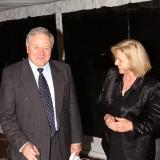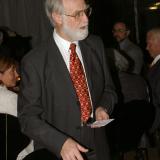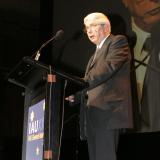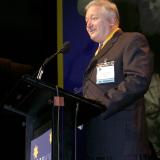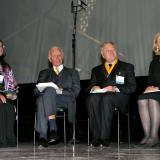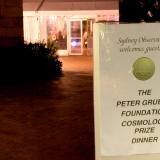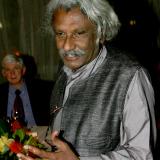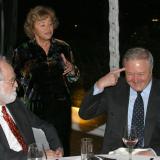2003 Gruber Cosmology Prize
Professor Rashid Sunyaev's pioneering studies on the nature of the cosmic microwave background and its interaction with intervening matter led to new cosmological models. Considered one of the most effective scientific bridges between the East and West, Professor Sunyaev maintains his affiliation with the Space Research Institute in Moscow as well as serving as a director of the Max-Planck-Institut für Astrophysik in Germany.
2003 Cosmology Prize Recipient
Laureate Profile
Rashid Sunyaev is one of the leading cosmologists of the Moscow school and of the world. He also is known for his affable manner, his extensive collaborative efforts, his ability to communicate advanced concepts to a lay audience, and his personal attention to detail.
Sunyaev was born in Tashkent, Uzbekistan, in former Soviet Central Asia in 1943. He trained in physics for six years at the Moscow Physical-Technical Institute, then studied at the Keldysh Institute of Applied Mathematics of the USSR Academy of Sciences. In 1968 he earned his Candidate of Sciences (equivalent to a doctorate) degree, and in 1973, his Doctor of Sciences degree in astrophysics from Lomonosov Moscow University.
He is perhaps the best known and certainly one of the most accomplished protégées of the famous Soviet cosmologist Yakov Zeldovich. In 1974 the two men organized a Department of Theoretical Astrophysics in the Space Research Institute (IKI) of the USSR Academy of Sciences, and Sunyaev headed the department until 1982. Then he organized a Department of High Energy Astrophysics in the IKI.
This High Energy Astrophysics department was responsible for the international orbital X-ray observatory that operated on board the MIR-KVANT space station for 12 years, bringing together Russian, British, Dutch and German X-ray instruments. A highlight of the mission was the discovery of hard X-ray emission for Supernova 1987A in the Large Magellanic Cloud, connected with radioactive decay during the star explosion. Sunyaev and a colleague predicted the observed radiation spectrum.
Sunyaev's department was also responsible for the operation of the GRANAT International Orbital Observatory launched in December 1989, and for the analysis of the scientific data it collected. That effort employed Russian, French and Danish scientific equipment. The spacecraft discovered three A-ray novae, detected quasi-periodic oscillations in the power spectra of four black hole candidates, and discovered the first superluminal radiosource in our galaxy.
In 1995, Sunyaev became a director of the Max-Planck-Institut für Astrophysik in Munich, Germany, where he continues to build an international reputation. He has made a point also to maintain an affiliation with the Space Research Institute in Moscow, despite the difficulties of budgetary cutbacks there, and has been credited with saving some of the scientific excellence of the former Soviet space program.
He is married to Gyuzal Sunyaeva, also a native of Tashkent, and he has three sons and one daughter.
Citation
The Cosmology Prize of the Peter Gruber Foundation is hereby proudly presented to Professor Rashid Sunyaev, director, Max-Planck-Institut für Astrophysik, Garching, Germany, for his pioneering studies on the nature of the cosmic microwave background and its interaction with intervening matter.
Hailing from the former Asian Soviet Republic of Uzbekistan, Sunyaev became one of the most important and prolific members of the Moscow group that pioneered Relativistic Astrophysics. Together with its illustrious leader Zeldovich, he studied the relic radiation from the Big Bang leading to early tests of cosmological models that are still valid and have provided impetus to one of the most active areas of observational cosmology.
Through continuing collaborations around the globe, Sunyaev remains among the most effective scientific bridges between East and West.




